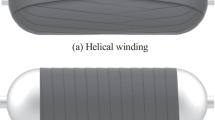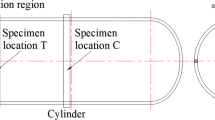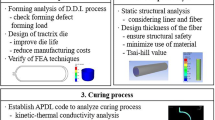Abstract
Due to the problems of fossil fuel exhaustion and environmental pollution, the use of hydrogen fuel has been increasing gradually, so there is also need of commercialization of hydrogen fuel cell vehicle. In order to increase its fuel efficiency, light-weightning and structural design, which are to optimize thickness and shape of the pressure vessel (end closure and boss) and winding angle of composite, have been required. This study has carried out as follows to obtain structural safety of hydrogen pressure vessel (type 4) under working pressure (700 bar). Plastic liner was designed using dome shape with isotensoid curve and spherical shape not to slip in the dome region while filament winding. After calculating the initial thickness of composite by netting theory, the composite thickness in both cylinder and dome parts to satisfy structural safety were obtained by FEM, changing the thicknesses calculated from theory. Also, optimal design of aluminium boss shape was performed using the response surface method to achieve light-weightning and increase of inner capacity. Based on the above results, structural safety of the optimal hydrogen pressure vessel (type 4) with the composite layer and boss shape finally determined was verified through FEA.
Similar content being viewed by others
Abbreviations
- r 1 :
-
Meridian curvature radius
- r 2 :
-
Circumferential curvature radius
- r o :
-
Ridius of boss
- r c :
-
Ridius of cylinder
- N θ :
-
Circumferential line load
- N ϕ :
-
Meridian line load
- σ f :
-
Longitudinal tensile strength of composite
- σ 1 :
-
Maximum principal stress
- σ max :
-
Maximum equivalent stress
- t :
-
Thickness of helical layer on the dome part
- t hoop :
-
Thickness of hoop layer on the cylinder part
- t helical :
-
Thickness of helical layer on the dome part
- α :
-
Laminated angle of helical layer on the dome part
- α c :
-
Laminated angle of helical layer on the cylinder
- P :
-
Internal pressure
References
N. L. Panwar, S. C. Kaushik and S. Kothari, Role of renewable energy sources in environmental protection: a review, Renewable and Sustainable Energy Reviews, 15 (2011) 1513–1524.
J. Gangloff, J. Kast, G. Morrison and J. Marcinkoski, Design space assessment of hydrogen storage onboard medium and heavy duty fuel cell electric trucks, Journal of Electrochemical Energy Conversion and Storage, 14/021004-1 (2017).
H. Barthelemy, M. Weber and F. Barbier, Hydrogen storage: recent improvements and industrial perspectives, International Journal of Hydrogen Energy, 42 (2017) 7254–7262.
J. Humberto, S. Almeida, H. Faria, T. Marques and C. Amico, Load sharing ability of the liner in type III composite pressure vessels under internal pressure, Journal of Reinforced Plastics & Composites, 33(24) (2014) 2274–2286.
J. P. B. Ramirez, D. Halm and J. C. Grandidier, 700 bar type IV high pressure hydrogen storage vessel burst — simulation and experimental validation, International Journal of Hydrogen Energy, 40 (2015) 13183–13192.
F. Hayato, Y. Akinori and M. Ryosuke, Structural optimization for cryogenic tank based on energy release rate, Composte Structures, 152 (2016) 883–890.
S. M. Cho, K. S. Kim, S. K. Lee, G. S. Jung, S. K. Lee and S. K. Lyu, Effect of dome curvature on failure mode of type 4 composite pressure vessel, International Journal of Precision Engineering And Manufacturing, 19(3) (2018) 405–410.
V. Alcantar, S. M. Aceves, E. Ledesma, S. Ledesma and E. Aguilera, Optimization of type 4 composite pressure vessels using genetic algorithms and simulated annealing, International Journal of Hydrogen Energy, 42 (2017) 15770–15781.
H. S. Roh, T. Q. Hua and R. K. Ahluwalia, Optimization of carbon fiber usage in type 4 hydrogen storage tanks for fuel cell automobiles, International Journal of Hydroen Energy, 38 (2013) 12795–12802.
T. Q. Hua, H. S. Roh and R. K. Ahluwalia, Performance assessment of 700-bar compressed hydrogen storage for light duty fuel cell vehicles, International Journal of Hydrogen Energy, 42 (2017) 25121–25129.
D. Leh, P. Saffre, P. Francescato, R. Arrieux and S. Villalonga, A progressive failure analysis of a 700-bar type IV hydrogen composite pressure vessel, International Journal of Hydrogen Energy, 40 (2015) 13206–13214.
Z. Lei, K. Sotiris and B. Adriaan, Design of filament-wound isotensoid pressure vessels with unequal polar openings, Composite Structures, 92 (2010) 2307–2313.
E. S. Barboza, M. Chludzinski, P. B. Roese, J. S. O. Fonseca, S. C. Amico and C. A. Ferreira, Experimental and numerical analysis of a LLDPE/HDPE liner for a composite pressure vessel, Polymer Testing, 30 (2011) 693–700.
Z. Lei, K. Sotiris and B. Adriaan, Design of filament-wound domes based on continuum theory and non-geodesic roving trajectories, Composite: Part A, 41 (2010) 1312–1320.
S. M. Cho, K. S. Kwang, K. M. Lee, S. K. Lee, Y. J. Lee and S. K. Lyu, A study on cycling life and failure mode of type 3 cylinder treated with autofrettage pressure, Interantion Journal of Precision Engineering and Manufacturing, 17(12) (2016) 1685–1691.
Z. Kabir, Finite element analysis of composite pressure vessels with a load sharing metallic liner, Composite Structures, 49 (2000) 247–255.
M. D. Musthak, P. Madar and S. Narayana, Prediction of transverse directional strains and stresses of filament woun composite pressure vessel by using higher order shear deformation theories, International Journal of Composite Materials, 6(3) (2016) 79–87.
R. P. Nair and R. Kumar, A new concept in the design for filament wound composite pressure vessel, International Journal of Engineering Research and Science & Technology, 3(1) (2016) 208–213.
C. U. Kim, J. H. Kang, C. S. Hong and C. G. Kim, Optimal design of filament wound structures under internal pressure based on the semi-geodesic path algorithm, Composite Structures, 6792005 (2016) 443–452.
ASME, BPVC Section X — Fiber-reinforced Plastic Pressure Vessels, The American Society of Mechanical Engineers, New York City (2019).
M. G. Han and S. H. Chang, Failure analysis of a type III hydrogen pressure vessel under impact loading induced by free fall, Composite Structures, 127 (2015) 288–297.
Acknowledgments
This work was supported by National Research Foundation of Korea (NRF) grant funded by the Korea government (MSIT) (No. 2019R1F1A1058521).
Author information
Authors and Affiliations
Corresponding author
Additional information
Gunyoung Park is in a Doctor’s course in the School of Mechanical Engineering, Pusan National University, Busan, Korea. He received Master’s degree of Mechanical Convergence Technology at Pusan National University in 2018. His major research fields are metal forming, design of composite and pressure vessel.
Hyoseong Jang is in a Doctor’s course in the School of Mechanical Engineering, Pusan National University, Busan, Korea. He received Master’s degree of Creative Engineering System at Pusan National University in 2015. His major research fields are gear design and computational fluid dynamics.
Chul Kim is a Professor of Mechanical Engineering at Pusan National University, Korea. He received doctoral degree of Mechanical Engineering at Pusan National University in 2011. His major research fields extend into FEM simulation (structure, dynamic and fluid analysis), optimal structural design, CAD/CAM.
Rights and permissions
About this article
Cite this article
Park, G., Jang, H. & Kim, C. Design of composite layer and liner for structure safety of hydrogen pressure vessel (type 4). J Mech Sci Technol 35, 3507–3517 (2021). https://doi.org/10.1007/s12206-021-0723-9
Received:
Revised:
Accepted:
Published:
Issue Date:
DOI: https://doi.org/10.1007/s12206-021-0723-9




